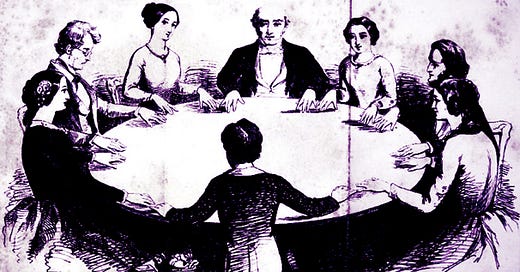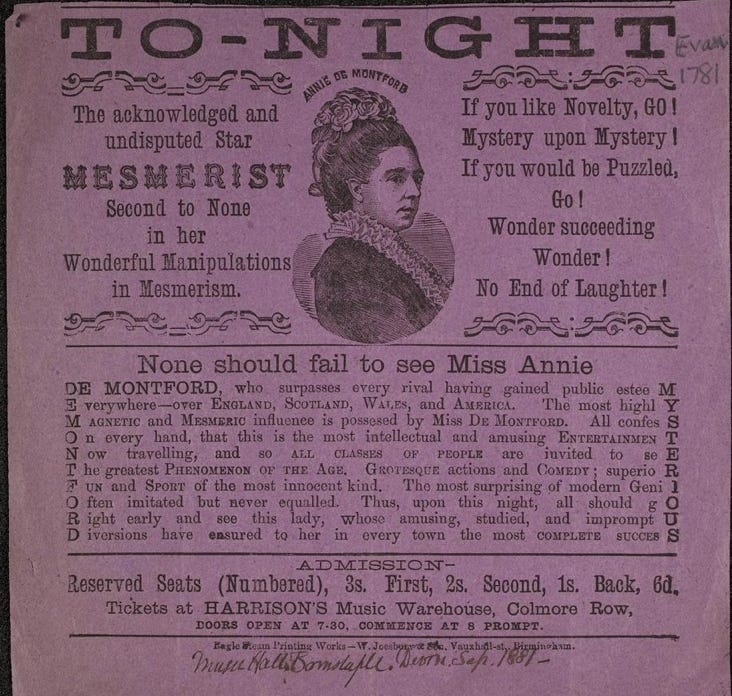The 19th Century was a time of great advancement during which many modern fundamentals of science and technology were forged. A basic understanding of geology emerged through the work of Sir Charles Lyell, expanding the age of the Earth from thousands into billions of years. Charles Darwin and Alfred Russell Wallace published works explaining the evolution of species through natural selection, causing many to re-examine the accepted tenants of divine creation. Advancements in astronomy, medical science, and electricity quickly followed. Photography, the telegraph, the telephone, and the internal combustion engine were all born out of this enlightened age and were instantly seized and developed upon ad infinitum. For all its perceived enlightenment, however, the Victorian Age was far from immune to the supernatural, and even as many shifted away from religious superstition, they could not altogether give up the ghost, so to speak.
One means of embracing the supernatural was the spiritualism movement. Spiritualism is a belief that the dead can be communicated with by way of psychic mediums who use a variety of methods, from seances to ghost writing to trances, under the belief that the dead are still “out there” evolving and talking on another plane of existence. Usually, this esoteric plane was something different than the conventional religious concept of heaven or purgatory, with many mediums of the time coining the term “Summerland” to explain this land of the dead.
Among the first popular examples of the movement were the Fox sisters, who came out of America in 1848. Kate and Margaret Fox were pubescent girls who claimed to communicate with a murdered man inhabiting their New York home. It was alleged that he “spoke” to them using a series of knocks or taps. Their claims attracted public attention which, in just months, spread throughout America, and the Fox sisters were soon joined by countless imitators, giving birth to the spiritualism industry. It did not take long for the movement to jump continents.
In 1852, American medium Maria Hayden came to London where she performed seances that delighted London society and generated publicity for spiritualism. Her performances typically involved table rapping, a “knock once for yes, twice for no” method similar to that used by the Fox sisters. Many newspapers and magazines spread word about her act, but the word was not always good. Detractors attacked the methods she and other rising mediums used, calling out their failures as much as the proponents of the movement praised their successes. Negative criticism aside, the movement spread throughout the United Kingdom over the century, almost becoming a religion of its own. Even Wallace, the great scientist and co-discoverer with Darwin of evolution via natural selection, took to it. As we’ll see, he was not the only man of logical faculties who joined the movement.
It would be easy to think, perhaps, that the Victorians were simply more gullible than we modern folk. The invasion of scientific advancement into traditional religious beliefs might have invited many to push back, embrace spiritualism, and give them reason to not entirely abandon the comfort of a belief in the afterlife. Also, they were in an age where visual effects and electricity were not a mainstay, and when spiritualists employed tricks such as spirit photography (super-imposing ghostly figures into photographs) and devices to knock on doors and rattle tables during a séance, it might be easy to assume the naïve Victorian was blindly falling for the ruse. That, however, seems too unlikely an explanation, as mediums and psychics continue to flourish today, when everyone is familiar with the deception that effects can employ. More stock, then, should be put into the idea that the Victorians, like us, had their share of individuals who wanted to believe, and hoped to connect with dead loved ones out of unassailable grief, and so allowed their emotions to be taken advantage of by the clever medium. Also like today, there were a huge sect of people who, whether they believed in the spirit world or not, simply loved to be exposed to it, scared by it, hopeful that - if they were non-believers teetering on the edge of belief – something remarkable may happen that would change their minds. And like going to a magic show, some would have wanted nothing more than to be entertained by the skilled conjurer in the form of a medium, and happily paid for the price of admission.
Most mediums were women. For one, it was accepted that women were better mediums because they had the “delicate, sensitive nervous systems,” to allow them to connect with spirits. Secondly, men were simply not trusted, being called out as charlatans from the moment they came out as psychics. Whether conducted by man or woman, it was important for the spiritualist to hook their clients in, to keep them paying, and coming back for more. One trick employed would be what is now referred to as “cold reading,” where a medium gains information about their client through studying their body language and coaxing answers with the use of manipulative questioning. This gives a perception of heightened insight on the medium’s part which they attribute to ghostly communication while, really, the intuitions are coming unconsciously from the duped client. The power of selective memory is also relied on. That is, a medium’s “positive hits” when expressing contact with the dead are highlighted, whereas the “negative hits” are forgotten. It’s a similar idea to when someone is thinking of a friend or family member, and in the middle of that thought process the phone rings with a call from that very person. It’s striking, giving one the sense of some sort of personal psychic acumen all while ignoring the many times one may have thought about that person and the phone never rang. So, the skilled medium did not need to be a gifted psychic so much as an expert exploiter of odds the way a casino or fairway carny needs to be. For every ten bad guesses at an attempted spiritual insight, all they had to do was shift focus to the one lucky guess they may have stumbled upon to keep their client intrigued.
Yet, despite the questionable practises of many mediums and the revelations from the debunkers who employed scientific tests to expose them, and even eventual admissions of fraud from the Fox sisters, legitimacy toward spiritualism continued throughout the Victorian Era. In 1882, the Society for Psychical Research was founded in London with a mandate of investigating spiritualism and authenticating hauntings and psychic abilities. While the society took many claims seriously, it was also noted for calling out fraud where it was detected. Otherwise, the organization had the appeal of granting perceived scientific value to mesmerists, mediums, and ghost hunters who appeared to have some legitimacy, and published a regular journal of its research. However, it also drew scorn from spiritualists who felt its testing standards were too rigorous, causing the society to readily dismiss proof of the psychic world when they shouldn’t have. The SPR still operates today.
Despite much back-and-forth over its validity, other notables from the era joined the cause to support spiritualism. Editor of the Pall Mall Gazette and perhaps the first great investigative journalist of the modern era, W.T. Stead, stated his support for all things supernatural. Having achieved journalistic greatness in the 1880’s for exposing child prostitution in London society and forcing parliamentary changes to laws to protect children against such crimes, Stead would go on to publish the periodical Borderland from 1893 to 1897, in which he documented serious science news interspersed with accounts of psychical research, spiritualism, “true” hauntings, and the occult. Stead embraced all manner of technological advances and was one of the first editors to make telephones a fixture of London’s newsrooms. He felt that such technology may one day be adapted to communicate with the dead. Unfortunately for him, no one from the other side bothered to communicate that he should not board the RMS Titanic on its tragic maiden voyage in April 1912, during which Stead lost his life.
Another Victorian celebrity who pushed for spiritualism was Conan Doyle, the doctor and author who created the great detective Sherlock Holmes. Despite the cold logic and deductive reasoning of his creation, Doyle happily separated himself from that image by pursuing ghost stories and accounts of fairies. While Holmes refused to join the cause, famously stating “No ghosts need apply” when seeking answers to a mystery in The Adventure of the Sussex Vampire (published 1924), Doyle did manage to budge his great Edwardian fictional character, Professor Challenger of The Lost World (1912) and other adventure stories, from a boisterous man of stern scientific beliefs into one who embraced the supernatural in The Land of Mist (1926).
The spiritualism movement should not be entirely scoffed at however, either then or now. Though it may seem to be the domain of the naïve and over-imaginative, it can also be looked at through the lens one might use to appreciate religion. While it’s true that it harbours many charlatans and crooks looking to defraud those seeking relief from their grief, the same criticism can be pointed at many practising religions, or at least those who abuse religions for such purposes. Yet there are, no doubt, many mediums who believe in what they say and do with as much conviction as any priest or other religious leader does. If a grieving parent, heartbroken spouse, or anyone else seeking assurance that life does not end with death finds perceived comfort through spiritualism and truly believes in the results given to them, perhaps that is enough to justify it. The Victorians were no more immune from such convictions than we are today. As stated before, their quick embracement of spiritualism was likely a welcomed opportunity to fill a void opened in the face of religious scrutiny due to the rapid flood of scientific understanding. Whether out of fear or philosophy, it seems inherent in human nature that we fill such a dark and prevalent cavity in our understanding of life with a solution for death, despite what assertions (or lack thereof) science gives to what is, ultimately, the fate of everyone.
Sources:
Luckhurst, Roger. Article: “The Victorian Supernatural.” British Library. 15 May 2014. https://www.bl.uk/romantics-and-victorians/articles/the-victorian-supernatural
Derbyshire, David. Article: “The Psychology of Spiritualism: Science and Séances.” The Guardian. 20 October 2013. https://www.theguardian.com/science/2013/oct/20/seances-and-science
"Hayden, Maria B. (ca. 1852) ." Encyclopedia of Occultism and Parapsychology. . Encyclopedia.com. 19 October 2023 <https://www.encyclopedia.com>.
Wikipedia contributors. "Society for Psychical Research." Wikipedia, The Free Encyclopedia. Wikipedia, The Free Encyclopedia, 17 Oct. 2023.
Penner, Sarah. Article: “Spirits, Scams and the Victorian Seance.” Crimereads.com. 9 March, 2023. https://crimereads.com/spirits-scams-and-the-victorian-seance/







